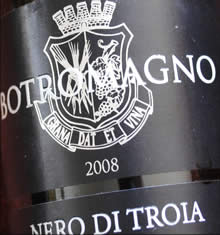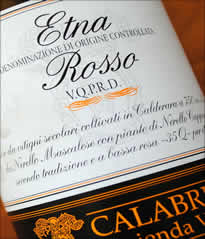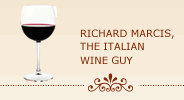two fine red wines from southern Italy for april 2013
Wine for april - Under $25
Botromagno, Nero di Troia 2008 (about $17)
The Botromagno winery is located Gravina, a small town in west-central Pugia located not far from the regional Basilicata border. The town is perched on the edge of a ravine pockmarked with caves that had been used by ancient people as far back as Neolithic times. The terrain around Gravina is rocky and hot with a harsh edge that incongruously provides a hospitable environment for the vineyards and olive groves that carpet the area.
The Cantina Botromagno is relatively new. It came into being in 1991 when the D’Agostino family merged its business operations with the local cooperative winery that had for decades provided local families with a variety of inexpensive but uninspired wines.
The Botromagno winery continues to rely on the same local farmers for its grapes that had formerly supplied the cooperative. However, the winery implemented strict standards for growing quality grapes that its suppliers must adhere to. These tight quality-control standards combined with substantial investment in facilities and modern winemaking technologies have, along with a dose of inspired winemaking, enabled the winery within a relatively short period of time to become one of Puglia’s premier winemaking facilities. The winery practices natural winemaking processes and its state-of-the-art winemaking cellar has won several environmental certifications and awards.
The winery produces a variety of red and white wines produced from primarily local native grape varieties such as Malvasia, Greco di Tufo and Bianco di Alessano for whites and Nero di Troia, Primitivo and Negroamaro for reds.
The Nero di Troia (also known locally as Uva di Troia) is the estate’s primary red variety. It is an ancient grape variety the origins of which are nebulous. Some believe that the variety originated in Asia Minor and was brought to Italy by the Greeks when they first colonized southern Italy. Whatever its origin, the variety has found a home in Puglia, especially in central and northern Puglia where it thrives. The variety does not travel well and is little found elsewhere.
As the word “Nero” in its name implies, the grape is deeply colored and has a tough skin. Historically, it produced wines with substantial body  and tannins and so was usually blended with other grapes to produce softer and less tannic wines. However, changes in viticultural and cellar practices in recent years have enabled producers to fashion Nero di Troia wines that are softer, more aromatic and more approachable than their predecessors. As a result, wines made exclusively with Nero di Troia have become more common and are gaining popularity with in-the-know wine specialists and consumers alike. These newer Nero di Troia wines will generally have delicate floral aromas, decent acidity, ripe tannins and a flavor profile that, in my opinion, is very Nebbiolo-like.
and tannins and so was usually blended with other grapes to produce softer and less tannic wines. However, changes in viticultural and cellar practices in recent years have enabled producers to fashion Nero di Troia wines that are softer, more aromatic and more approachable than their predecessors. As a result, wines made exclusively with Nero di Troia have become more common and are gaining popularity with in-the-know wine specialists and consumers alike. These newer Nero di Troia wines will generally have delicate floral aromas, decent acidity, ripe tannins and a flavor profile that, in my opinion, is very Nebbiolo-like.
Botromagno’s 2008 Nero di Troia is made entirely with Nero di Troia grapes that have been aged in stainless steel tanks for 20 months. After fermentation, the wine spends an additional 6 months ageing in the bottle prior to release for sale.
Botromagno’s ’08 Nero di Troia is an impressive wine. It has a deep ruby color and alluring fruity aromas with a hint of violets. Its plum and dark fruit flavors with kitchen spice notes have a pleasing rustic accent. The wine’s plush, velvety texture is balanced with good acidity. It’s a fully mature, food-friendly wine that’s ready to drink now.
Botromagno’s Nero di Troia would be handy to have for dinners or other functions involving hearty pasta dishes, stewed or barbequed meats, roasted lamb or aged cheeses. A second bottle would probably come in handy.
Wine for april – $25 and over
Calabretta, Etna Rosso 2002 (about $27)
The Mount Etna region in eastern Sicily currently is the most vibrant and dynamic wine region in Sicily - if not all of Italy. This may be thought of as a renaissance of sorts since Mount Etna actually has had a vibrant winemaking culture as far back as the 6th century BC when the ancient Greeks first colonized southern Italy.
However, after an extended period of decline and relative obscurity, Etna’s wine culture is again flourishing and wineries in the Mount Etna region are today producing some of Italy’s most exciting red and white wines. This has precipitated a land rush of sorts as producers from elsewhere in Sicily and even mainland Italy are scrambling to buy vineyard properties on Mount Etna’s slopes. The influx of new wineries bringing different winemaking backgrounds and styles with them in conjunction with a cadre of winemakers that have been producing Etna wines for generations has created a vibrant and dynamic wine scene.
One prominent Etna winery is the Calabretta winery which has been crafting wines in the Mount Etna area since the turn of the previous century. The family-owned and operated winery is currently headed by Massimiliano Calabretta, the third generation of this winemaking family. From its relatively small 20 acre vineyard located at an elevation of about 2,500 feet above sea level, the Calabretta winery turns out a number of highly-regarded red and white wines.
While many Sicilian wines today are made in what might be termed the “modern” style, Calabretta’s winemaking style is firmly planted in the “traditional” or “classic” camp. Its wines are crafted using traditional Etna winemaking practices that have been around for generations. While these traditional procedures are time-consuming and expensive and may be considered “quaint” by some, they are standard operating procedure at the winery.
The estate’s flagship Etna Rosso wine (Etna red wine) is made with Nerello Mascalese grapes blended with a small amount of Nerello Cappuccio grapes. Both are native varieties that thrive in Mount Etna’s challenging rocky, volcanic and dry environment.
The grapes are meticulously harvested by hand in mid to late October from 70 to 80-year-old vines in organically-farmed vineyards. However, the wine’s most distinguishing feature is the long ageing period for the wine. The Etna Rosso spends approximately 3-1/2 years ageing in large botti-size oak casks so as to soften the tannins and add complexity to the wine. It then is aged for several additional years in the bottle before release for sale.
I find this awe-inspiring. How many vintners today have t he patience, discipline and old-fashioned pride in their product to withhold their wines from the market for years until such time as they have been aged appropriately before handing them off fully ready to be enjoyed by consumers?
he patience, discipline and old-fashioned pride in their product to withhold their wines from the market for years until such time as they have been aged appropriately before handing them off fully ready to be enjoyed by consumers?
The 2002 Etna Rosso by Calabretta is a remarkable and lovely wine evocative of a seasoned Barolo from the La Morra area. The wine is garnet red in color with a slight rust color on the edge. Gentle swirling of the glass releases lovely and complex cherry, coffee and sweet kitchen spice aromas. It is full-bodied but elegant with intricate layers of red fruit flavors balanced with good acidity and soft, nuanced tannins. The finish seems never ending. It’s a remarkable wine by any measure that is even more so when you factor in what I think is an exceptionally low price for a wine of this stature.
So here’s my recommendation. Assuming you want to enhance the quality of your wine portfolio and make your life at least a scooch more rewarding and enjoyable, search out this wine and buy as much as your wallet permits. You won’t regret it.
©Richard Marcis
April 7, 2013
To view other wine of the month selections, see Monthly Wine Reviews


